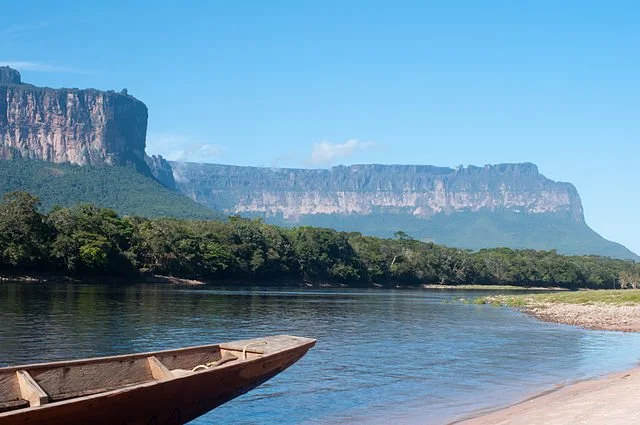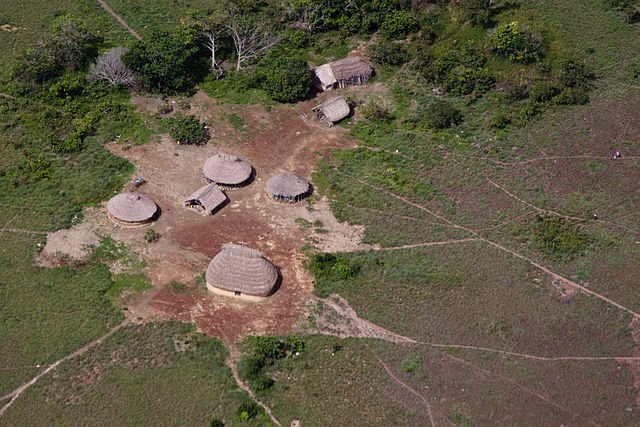The Myth of Responsible Mining Debunked: Venezuela’s Orinoco Mining Arc
View of Canaima National Park, a UNESCO World Heritage Site currently threatened by mining projects. (Photo: JEISSY TROMPIZ, CC BY-SA 3.0)
In 2016, Venezuela’s government designated the Orinoco Mining Arc for extractive activities. What is allegedly envisioned as a development zone, meant to increase the mining revenue of the nation, is in fact an epicenter for human rights violations, illicit mineral extraction and ecocide. However, the authoritarian Maduro regime continuously denies and distances itself from these crimes. As this analysis shows, in officialist Venezuelan media outlets, many things are left unsaid regarding this highly contested territory.
Although receiving some attention internationally in the last few years, the Orinoco Mining Arc (also referred to simply as arco minero, or arco) remains a relatively underreported issue in Venezuelan corporate media. Some environmental organizations, notably SOS Orinoco, campaigned against the development zone as well as created reports outlining the main issues the mining arc causes, but Venezuelan press continues to downplay the situation.
VTV: A Principal Tool for Propaganda
A particularly important news outlet for this conversation is Venezolana de Televisión, or VTV. This media organization has largely served the Chavez-Maduro regime in distributing propaganda on open television and the internet. In fact, a 2006 study conducted by Human Rights Watch showed that more than half of the channel’s broadcasting was committed to pro-government news and “opinion programs heavily biased against the opposition.”
Most notably, VTV aired the weekly program Aló Presidente, in which late president Hugo Chávez would give audience members the opportunity to have a phone call with him live. The unscripted talk-show started at 11 AM and did not have a finish time. The longest he stayed live was 8 hours straight. This is to show that VTV is widely controlled by the state and has a longstanding pro-government bias that heavily affects the stories it covers.
The Government Plays a Role in Illegal Activities
Articles on the mining arc are scarce, but present, on VTV’s online platform. However, there is a significant amount of information left unsaid. In one article, VTV argues that the government is reiterating the prohibition of mining activities within National Park limits:
“[The minister for ecological mining development] reaffirmed Pemón indigenous leaders about the prohibition of mining activities in National Parks[,] with the objective of protecting the territory and strengthening the mechanisms to displace capitalist and destructive activity in this country.”
The article foregrounds illegal mining and the looting of natural resources that threatens the original goal of the arco. It does so by placing exploitation by “forces outside the state” at the center of the coverage. There, the assumption is that the looting of the arc is detached from the government. But VTV is gatekeeping information about how the government allowed for illegal mining in the first place, how it benefits from it, and how the Venezuelan Armed Forces (FANB) are currently controlling most of the so-called illegal mines.
It is useful to contrast the official view with articles from environmental news outlets, such as Mongabay and Global Forest Watch. The latter explains that “many of the mines are directed by Venezuelan gangs or Colombia guerrilla groups that operate under the protection of the Venezuelan military.” Similarly, the initiative Digging Into the Mining Arc by InfoAmazonia interviewed government dissident Clíver Alcalá Cordones, a Major General who held command in the mining regions. In the interview, Alcalá confirmed that “the army receives significant benefits from illegal mining, while the gangs that operate the mines use violence to maintain control.” Essentially, armed gangs pay the military in order to carry illegal mining operations.
Regarding the protection of National Parks, the original VTV article implies that National Parks were outside of the official designated mining zone from the beginning. However, according to Mongabay, in the original plan Maduro announced there are four areas in Bolivar State that overlap with “legally protected environmental preserves and indigenous territories”, including Canaima National Park, a UNESCO World Heritage Site.
Presenting The Government and Indigenous Peoples as a United Front
There are around 10 indigenous groups in the Orinoco region that are threatened by mining projects. Some of them include the Pemón, Warao, Pumé and Kariña people. The Pemón people in particular have been a subject of discussion under official discourse, supposedly for their disposition to increase the efficiency of mining projects. But there are greater reasons behind why indigenous groups have become associated with the mines.
Aerial View of Churuatas, traditional Pemón Households. (Photo: Luis Ovalles, CC BY-SA 3.0)
In this article, VTV naturalizes (that is, names things as if they were natural rather than constructed, turning history into nature) the displacement of Pemón people from their traditional economic activities and their participation in the mining sector. It portrays Pemón people as long-standing, active members in the mining projects. The article fails to reference that the decay of tourism due to the economic crisis, which was the main source of revenue for the Pemón, forced them into the mining sector.
Additionally, the article gatekeeps, or filters out, the fact that plenty of Pemón people were displaced by mining zones, either forcing them to move elsewhere or to join the mining workforce. According to The Conversation, the Venezuelan government consistently presents itself “as a champion of the indigenous cause.” But there is evidence that the Government’s mining project has little interest in the well-being of indigenous groups. El Pitazo reported a massacre in the mining community of Ikabarú in 2019. Anonymous indigenous leaders released a statement asserting that “from the highest ranking officer, to the lowest, they are all accomplices of this environmental disaster…This government decreed the death and disappearance of the native peoples.”
These testimonies provide a contrast with the government’s official discourse of their role in the mining arc. First, it shows that the government is indeed affiliated with violence and crimes perpetrated in the arc, and that these irregularities are not a product of outside forces. Second, it shows that the government seeks to naturalize indigenous people from the region as active and voluntary members of the mining sector, as opposed to people who were left without a choice. As such, it becomes evident that VTV plays a substantial role in presenting news reports within the ideological framework of Maduro’s goals and narratives.
The Need for Truthful Coverage of The Mining Arc
As a free-access state channel, VTV has a responsibility to deliver truthful information to the public. In many areas, where cable TV is not available, VTV can become one of the only sources of information for millions of people. As such, it is important to conduct this type of analysis on the narratives this outlet enforces. Thousands of lives are being, and will be, affected by the environmental and humanitarian crimes that occur in the mining arc. Indigenous people and involved activists deserve truthful coverage so that their efforts to protect the land and themselves can bear optimistic results.
Note: Some Spanish texts have been translated by the author.


